#CIMABUE
Explore tagged Tumblr posts
Text
Time Travel Question 55: Medievalish and Earlier
If you could travel through time, but only to see something for Research or for Fun, not to change anything, what would you pick? Yes, you may have a Babel Fish in your ear to translate.
These Questions are the result of suggestions a the previous iteration. This category may include suggestions made too late to fall into the correct earlier time grouping. In some cases a culture lasted a really long time and I grouped them by whether it was likely the later or earlier grouping made the most sense with the information I had.
Please add new suggestions below if you have them for future consideration. All cultures and time periods welcome.
#Time Travel#Middle Ages#Basilica of Saint Francis of Assisi#Art History#Italian History#Cimabue#Giotto#Simone Martini#Pietro Lorenzetti#Pietro Cavallini#lithophones#History of Music#Homins#Prehistory#Minoans#mythology#Minoan mythology#Ancient Greece#Ancient Rome#Roman Religion#Ötzi#Ötzi the Ice Man#Neanderthal#Neanderthals#Fashion History#Folklore#History of Food
85 notes
·
View notes
Text

"The Mocking of Christ" by Cenni di Pepo known as CIMABUE (Active in the years 1272 to 1302).
The long-lost work by 13th century Florentine master has been found to be hanging over a kitchen hot plate in the French town of Compiègne in 2019.
It is believed that the piece is part of a diptych made up of eight scenes centered on the passion and crucifixion of Christ.
Two other related panels, Flagellation of Christ and the Madonna and Child Enthroned between Two Angels, were bought by the Frick Collection in New York in 1950 and the National Gallery in London in 2000, respectively. It too was lost for centuries before a British aristocrat found it in his home in Suffolk.
Only around eleven of Cimabue's paintings are know in the world.
The Louvre Museum in Paris has added a “national treasure” to its collection.
Tempera and gold leaf ground on a poplar panel.
25.8 x 20.3 cm.
#art#history#style#painting#christ#cenni di pepo#cimabue#13th century#france#tresor#lost treasure#tempera#gold leaf#louvre museum#national treasure
73 notes
·
View notes
Text
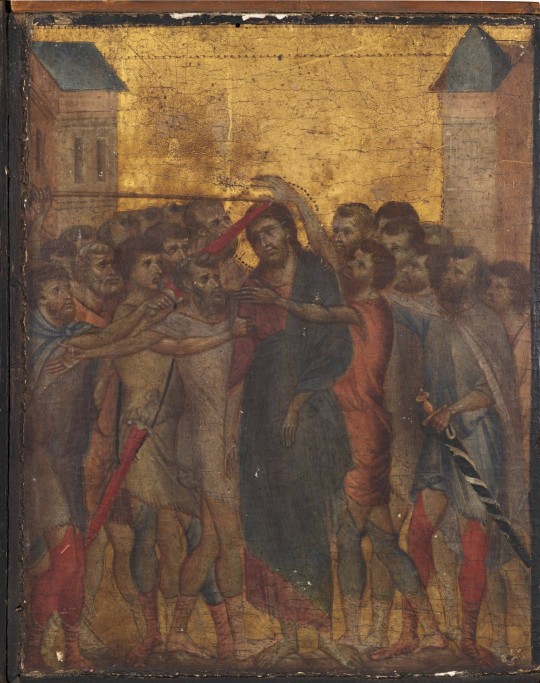
Cimabue - The Mocking of Christ. 1270 - 1300
42 notes
·
View notes
Text

Frederick Leighton, A Nossa Senhora de Cimabue Transportada em Procissão por Florença (1855)
3 notes
·
View notes
Text
Crucifix of San Domenico | (detail, Hand of Christ) - Cimabue
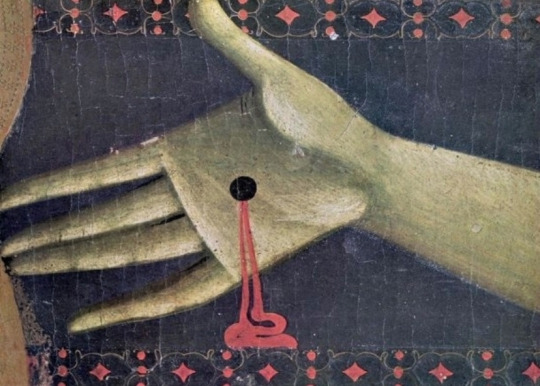
reposted from X
#historicart#hand of Christ#tw:blood#artwork#historic things#religion#religious artwork#dark artwork#darkart#Christ#Cimabue
7 notes
·
View notes
Text
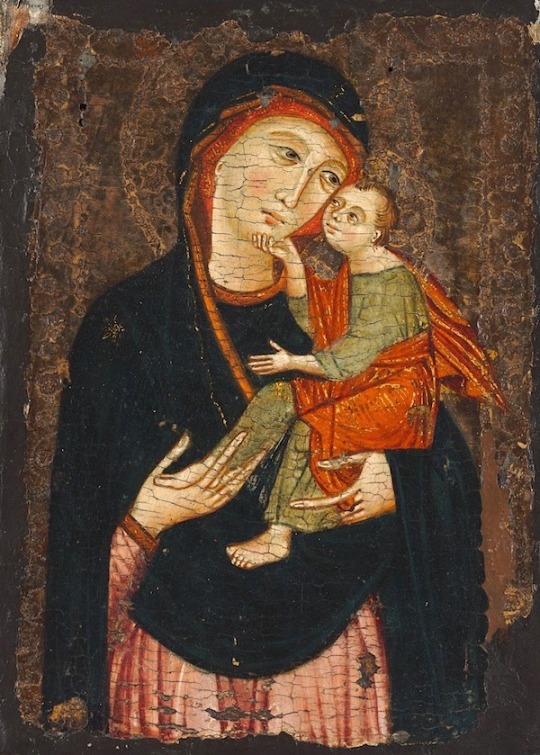
Daily Painting
Cimabue THE VIRGIN AND CHILD (1295)
32 notes
·
View notes
Text
Cimabue
L'ha detto il Vasari, che oltre a pittore fu anche uomo rinascimentale dai molti ingegni e primo storico della pittura "moderna" con Le vite de' più eccellenti pittori, scultori e architettori, che tutto inizia con Cimabue, maestro di Giotto. Siamo nella seconda metà del ducento quando a Firenze tale Cenni di Pepo, questo il suo vero nome, inizia a innovare l'arte bizantina cercando di sfuggirne l'usuale fissità.
In particolare sui crocifissi, dicono, Cimabue diede saggio del suo nuovo stile: inarcò ancora di più la curva del corpo, definì meglio i muscoli attraverso un uso più sapiente della sfumatura, iniziò a far risaltare ancor di più i tratti drammatici del volto. Ecco un raffronto fra lo stile di Giunta Pisano (a sinistra) e quello di Cimabue (a destra).
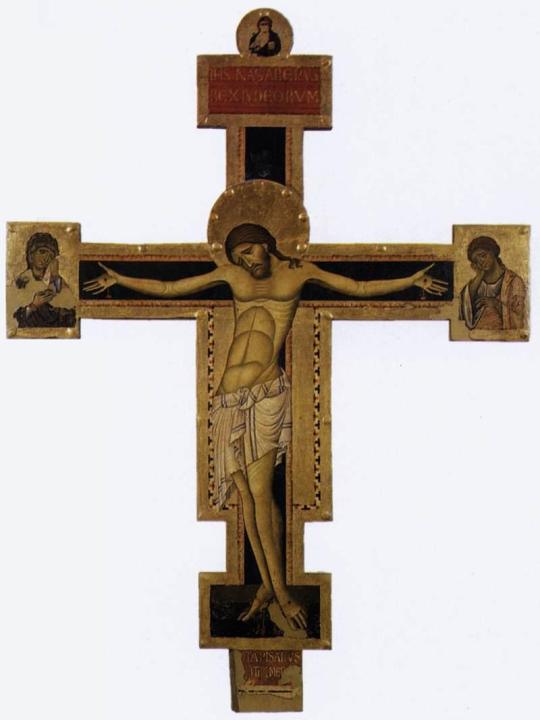
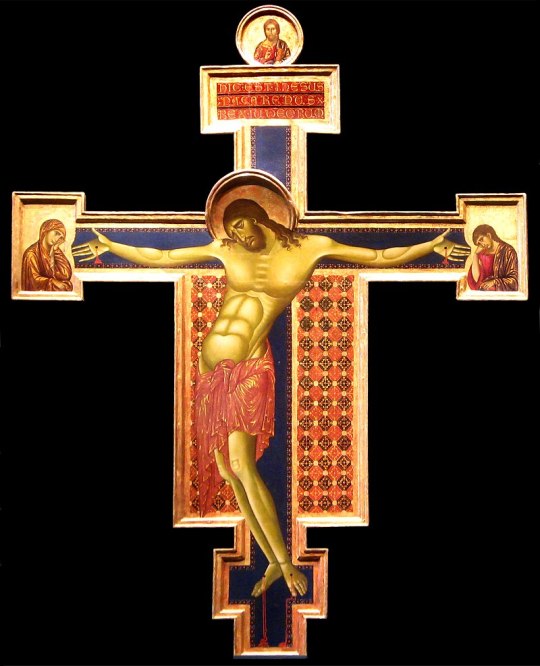
Lentamente la pittura si stava spostando verso un maggiore realismo della figura contro il simbolismo dell'arte bizantina classica, un realismo di cui fu riconosciuto come primo maestro Giotto (e Cimabue come suo precursore).
[nota: che la pittura andasse verso un maggiore realismo non significava che fosse conseguentemente migliore di quella precedente, come se il valore di un pittore si misurasse dall'abilità di copiare meglio la realtà. Si tratta semplicemente di un concetto nuovo che si svilupperà via via fino ai giorni nostri, almeno fino alla nuova rivoluzione dell'arte astratta]
12 notes
·
View notes
Text

THE FLAGELLATION OF CHRIST, 1280 by CIMABUE
This panel shows one of the most important moments in the Passion. Before being crucified and killed by the ROMANS, CHRIST was bound to a pillar and flogged by ROMAN troops.
While CHRIST and his tormentors are in the background, the background is covered in gold (a reflection of CIMABUE’s BYZANTINE roots), and the two towers represent the architecture of OLD JERUSALEM.
The positioning of the figures and architectural elements shows CIMABUE experimenting with illusionistic spatial effect, though he would never quite master the art of creating the complete illusion of perspective.
This is the only work by Cimabue in a public collection in the United States. It was purchased for the Frick collection in 1950 on the initiative of Henry Clay Frick's daughter, Helen Clay Frick.
#the flagellation of christ#cimabue#romanticism#romantic artist#romantic art#romantic paintings#romantic#romantic art
3 notes
·
View notes
Photo





unknown icon painter Virgin of Vladimir (C12th) tempera on wood panel 104x69cm Made in Contantinople, transfered to Russia. http://www.tretyakovgallery.ru/en/collection/_show/image/_id/2216
Cimabue Virgin Enthroned with Angels (c1290-95)
Piero della Francesca (1415-92) Republic of Florence The Madonna of Mercy oil (1460-2) and tempera on wood panel 180cm http://www.ilpozzeto.it/dellafrancesca/emain.html
Jan Van Eyck (c1390-1441) Flanders Madonna of Chancellor Rolin (c1435) oil on panel 66x62cm
7 notes
·
View notes
Text
100+ Famous Modern Art Artists of All Time

2/8/2024 ♦ Framed Poster Print ♦ Canvas Print ♦ Metal Print ♦ Acrylic Print ♦ Wood Prints 🌐 Worldwide shipping
#alberto giacometti#john constable#jacques louis david#giorgione#arshile gorky#pieter bruegel#simone martini#franz marc#theodore géricault#william hogarth#camille corot#georges braque#berthe morisot#james whistler#Frederic Edwin Church#georges de la tour#Élisabeth Louise Vigée Le Brun#cimabue#dante gabriel rossetti
4 notes
·
View notes
Text
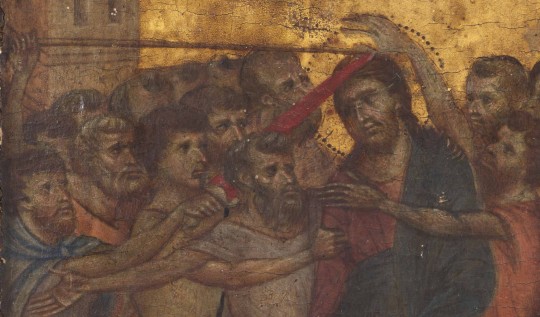
Cimabue - The Mocking of Christ. Detail. 1270 - 1300
38 notes
·
View notes
Text
Un Trésor national voir Mondial : redécouvert dans une cuisine, un rarissime tableau de Cimabue entre au musée du Louvre
A National treasure or more a World treasure: found in a kitchen , a painting of Cimabue on a wood panel is coming in the Louvre Museum (Paris) !!!!!
Par Anne-Sophie Lesage-Münch le 02.11.2023 Connaissance des Arts
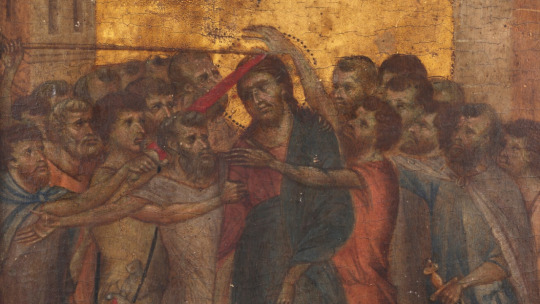
Cimabue, Le Christ moqué (détail), 25,8x 20,3 cm, peinture à l'oeuf et fond d'or sur panneau de peuplier, Actéon Senlis, vente 27 octobre 2019.
Après trois années d’attente, La Dérision du Christ de Cimabue, petit panneau de bois du XIIIe siècle devenu le tableau primitif le plus cher du monde, rejoint les collections nationales.
Une bien discrète annonce pour une acquisition extraordinaire. En ce premier jeudi de novembre, où la tempête Ciaran occupe tous les esprits, le ministère de la Culture a diffusé sans crier gare un communiqué que beaucoup attendaient. Voilà en effet près de trois ans que la question ressurgissait de loin en loin : mais que devient le Cimabue sauvé d’une cuisine ? On apprend donc officiellement aujourd’hui que La Dérision du Christ, petit chef-d’œuvre miraculé classé Trésor national, rejoint les collections du musée du Louvre.
Ceci n’est pas une icône
Dans la famille des chefs-d’œuvre perdus et fortuitement redécouverts, ce petit panneau de bois peint d’à peine 25 cm de haut tient une place plus que remarquable. Son histoire récente débute en juin 2019 lorsque Philomène Wolf, commissaire-priseur pour la maison de vente Actéon, travaille sur l’inventaire de la maison d’une nonagénaire à Compiègne. Elle remarque alors, accroché dans la cuisine au-dessus des plaques de cuisson, ce que jusqu’alors la famille considérait comme une simple icône russe. De fait, l’art de Cimabue s’ancre dans la tradition de la peinture byzantine dont il s’affranchit cependant (et c’est là tout son génie) pour développer une nouvelle esthétique à l’orée de la Renaissance.

Classé Trésor national en 2019, le tableau La Dérision du Christ de Cimabue rejoint les collections du musée du Louvre. ©Actéon
L’œuvre est alors soumise à l’expertise du cabinet Turquin qui l’attribue finalement, après des mois de recherche, au fascinant peintre florentin, maître de Giotto, dont on ne connaît à ce jour qu’une quinzaine de réalisations. Cette étude permet également de comprendre que le panneau appartient à un diptyque (un objet de dévotion privée) composé de huit scènes de la Passion du Christ, datant de 1280, dont seulement deux autres panneaux nous sont parvenus : La Flagellation du Christ, conservé à la Frick Collection de New York depuis 1950, et La Vierge à l’Enfant, acheté par la National Gallery à Londres en 2000.
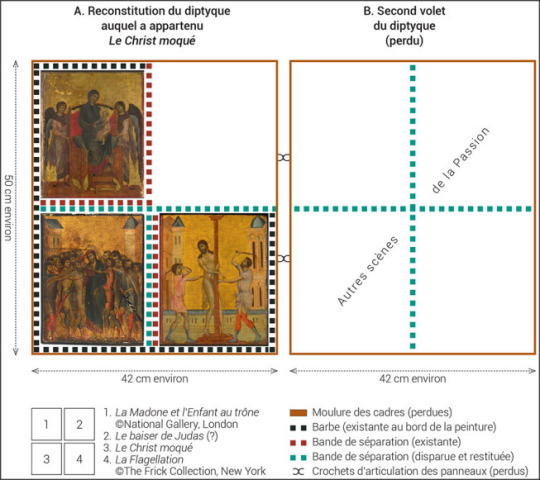
Reconstitution du diptyque auquel a appartenu le Christ moqué de Cimabue ©Actéon
Une exposition exceptionnelle en 2025
Estimée entre 4 et 6 millions d’euros, l’œuvre est présentée aux enchères le 27 octobre 2019 où elle atteint le prix de vente record de 24 millions d’euros, devenant ainsi le tableau primitif le plus cher du monde (et accède également au 8e rang des tableaux anciens les plus chers jamais vendus). Le musée du Louvre, qui souhaitait se porter acquéreur, n’a alors pas encore pu réunir la somme nécessaire à sa préemption. Quelques semaines plus tard, la veille de Noël, on apprend que l’œuvre est finalement classée « Trésor national », un label qui exclut de fait toute autorisation de sortie du territoire français durant une période de 30 mois. Cette manœuvre va alors laisser le temps à l’administration de réunir les fonds pour l’acquisition du chef-d’œuvre.
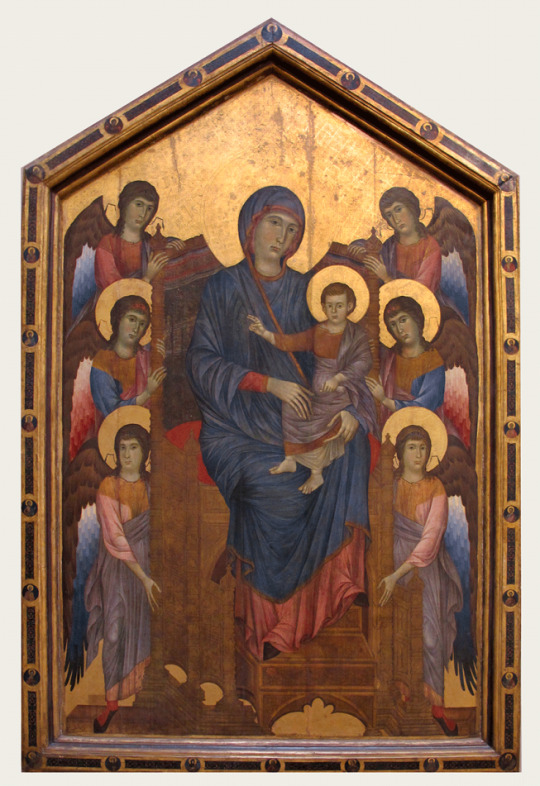
Cimabue, La Vierge et l’Enfant en majesté entourés de six anges (Maestà), vers de 1275 à 1300, tempera et fond or, musée du Louvre ©Wikimedia Commons
Aujourd’hui le musée du Louvre peut se féliciter de l’entrée dans ses collections de cette œuvre insigne qui, comme l’explique Laurence Des Cars, présidente-directrice du musée « constitue un jalon crucial dans l’histoire de l’art, marquant la fascinante transition de l’icône vers la peinture ». La Dérision du Christ met déjà en œuvre des questions qui deviendront centrales dans les arts de la Renaissance, en particulier la représentation de l’espace, de la lumière ou encore des sentiments humains. Elle rejoint la monumentale Maestà, autre chef-d’œuvre du peintre florentin qu’abrite l’institution parisienne, et qui fait actuellement l’objet d’une campagne de restauration. Les deux tableaux, qui à grande comme à petite échelle font la démonstration du caractère révolutionnaire de l’art de Cimabue, seront au cœur d’une exposition au printemps 2025.
#cimabue#louvre#museedesbeauxarts#artists on tumblr#france#artistsoninstagram#artistsupport#meet the artist#painter#aesthetic#kunstdruck#kunstmuseum#kunst und kultur#kunstgalerie#statens museum for kunst#museum
5 notes
·
View notes
Photo
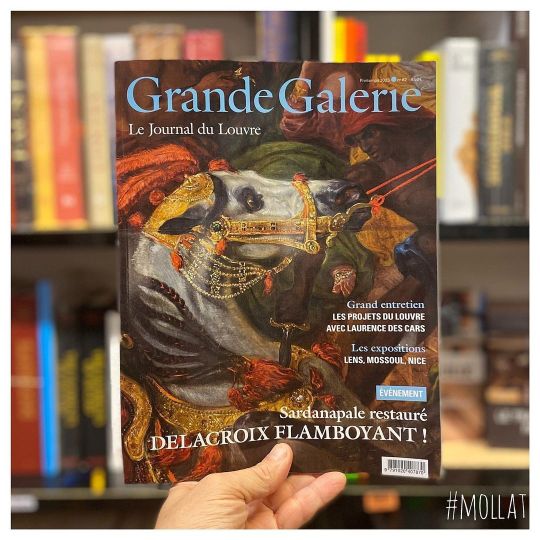
📣 Le très beau numéro de Grande Galerie Le Journal du Louvre @museelouvre est disponible au Rayon Beaux-arts de la @librairie_mollat Au sommaire : un grand entretien sur les grands projets du Louvre avec Laurence des Cars, la restauration de La Mort de Sardanapale de Delacroix et de la Maestà de Cimabue, le portrait de grands mécènes du Louvre : Harry et Linda Fath et plein d’autres sujets passionnants encore comme le format perdu du Gilles de Watteau ou Feu ! Chatterton en résidence au Louvre… #grandegalerie #grandegalerielejournaldulouvre #lejournaldulouvre #delacroix #watteau #cimabue #feuchatterton #louvre #museedulouvre #librairie #mollat #bordeaux (à librairie mollat) https://www.instagram.com/p/CqLfzoDjlKi/?igshid=NGJjMDIxMWI=
#grandegalerie#grandegalerielejournaldulouvre#lejournaldulouvre#delacroix#watteau#cimabue#feuchatterton#louvre#museedulouvre#librairie#mollat#bordeaux
8 notes
·
View notes
Text
From kitchen wall to the Louvre: Cimabue show sheds new light on ‘father of Western painting’
A long-lost Cimabue panel discovered on a kitchen wall north of Paris in 2019 is at the heart of a landmark exhibition on the Florentine master, which opens at the Louvre on Wednesday, showcasing restored masterpieces and bringing to light his pioneering role at the dawn of the Renaissance.

View On WordPress
0 notes
